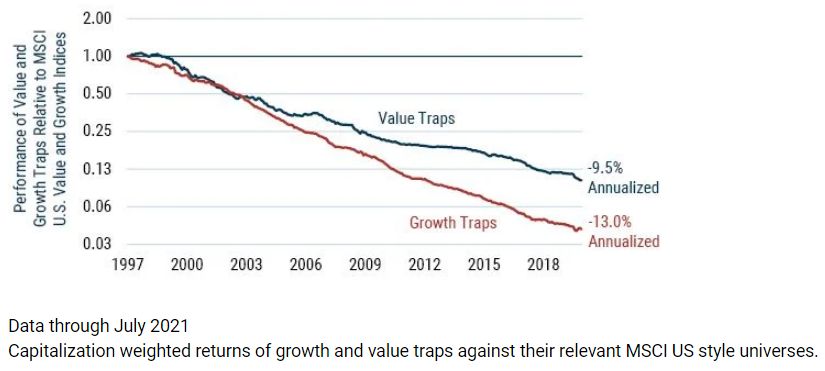In their latest insight titled – Value Traps vs Growth Traps, GMO explains why growth traps are worse than value traps. Here’s an excerpt from the article:
When Value disappoints, markets are mad. When Growth disappoints, they are merciless.
- Value traps are facts of life for value managers. A stock suffering from some temporary dark clouds appears temptingly cheap, and like the call of Sirens, it entices the intrepid Value manager. Alas, the company’s fundamentals disappoint yet again. It was a trap. The clouds were not temporary. And the market rightfully punishes the stock price further.
- Cautionary tales of Value traps are taught in finance texts around the world, and the term is a longstanding part of investment lexicon.
- Although most investors have never heard the term, “Growth traps” are even more insidious. The seduction is different, borne from grand narratives of disruptive technologies, hyper-growth, and breathtaking breakthroughs. But Growth stocks are no less prone to disappointment – there’s actually evidence they are slightly more likely to disappoint at certain points in the cycle1 – and their punishment can be even more dire.
- The chart above tracks a basket of Value and Growth trap stocks over 25 years.2 Value traps have underperformed their respective universe by a painful 9.5% per year. Growth traps have underperformed by an excruciating 13.0% per year.
- This makes sense: Growth stocks have lofty investor expectations, so when they fail to deliver, investors are merciless. Managers who get fooled are more likely to blow that name out of the portfolio, which is part of the reason we don’t hear much about them. Unfortunately, by then the damage is already done, and history shows there is a 30% to 40% chance that the stock will be replaced with yet another trap.3
- Why shine a light on growth traps today? Growth stocks around the world are priced with exceedingly high expectations.4 Recent names that have disappointed have been mercilessly repriced. What can you do about it? Lots. We’ve built a globally diversified short basket of stocks (part of a long-short strategy called Equity Dislocation) that is chock-full of candidates we believe are likely to fall short of the unrealistic expectations implied by their valuations. We have other strategies that can exploit this phenomenon in a multi-asset framework. Maintaining a Quality bias at a reasonable price is yet another way to play this. No matter, there are ways to navigate these dangerous waters.
1 See GMO Quarterly letter, Q2, 2021 for more detail on our Value and Growth trap research.
2 We had some discussion over how to define companies that disappoint. We didn’t want poor stock market performance to be part of the definition because that seemed like cheating. Looking at companies whose earnings disappoint is tricky because earnings forecasts are both gamed by analysts and companies, and because the definition of earnings reported by a company might be different from what the analysts used for their forecasts. The definition of sales isn’t as fuzzy, but single sales disappointment does not seem to do justice to the idea of a “trap.” So we decided on a definition that required both a disappointment in sales relative to forecasts and a drop in future sales estimates.
3 Growth managers are more prone to selling a disappointing Growth stock because once it disappoints, the stock truly is a bad fit. This is not true for a Value manager, who is more likely to hold on to some of these disappointing names given they were disappointments in the first place. This is why Growth traps are more insidious: the manager is more inclined to keep rotating into “new” disappointments.
4 The Price/Sales ratio (a proxy for sales growth expectations) for the S&P 500 was the highest in recorded history as of 11/30/2021, for example.
You can find the original article here:
GMO: Value Traps vs Growth Traps
For all the latest news and podcasts, join our free newsletter here.
Don’t forget to check out our FREE Large Cap 1000 – Stock Screener, here at The Acquirer’s Multiple:



